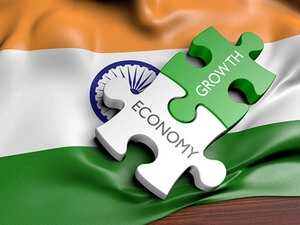 Agencies
AgenciesConfirmed
7,239,389
Deaths
110,586
Close on the heels of Q1's unprecedented GDP jolt, some more sobering news could be headed India's way, if one goes by the International Monetary Fund's latest World Economic Outlook.
According to the IMF report, India is about to slip below Bangladesh in per capita gross domestic product in 2020 as a result of lockdown impact.
The IMF sees India's per capita GDP (in dollar terms, at current prices) falling to $1,877 in 2020, a decline of 10.3 per cent. For Bangladesh, the corresponding figure is seen growing to $1,888, a rise of 4 per cent.
In per capita GDP terms, India was significantly above Bangladesh till a few years ago, but the gap has been substantially closed owing to the country's rapidly-rising exports. Besides, during the intervening period, while India's savings and investments remained lukewarm, the corresponding numbers for Bangladesh saw a sizeable surge.
If IMF's forecast hits the mark, that will leave India just ahead of Pakistan and Nepal in the regional GDP sweepstakes. It means others in South Asia — Bhutan, Sri Lanka, Maldives and of course Bangladesh — will be ahead of India.
Compared to the degrowth projected for India, the economies of Nepal and Bhutan are expected to grow this year, the report noted.
IMF's forecast for India is worse than RBI's projection of 9.5% contraction for the full fiscal. It also also gloomier than the forecast of World Bank which predicted a decline of 9.6% for FY21. In addition, the World Bank also said that the situation in India is "worse than ever".
India's contraction of 10.3% is going to be third sharpest fall in the world after Spain and Italy, the report said. It will also be the starkest decline among developing nations and emerging economies, it added.
Emerging economies other than China will witness a 5.7 per cent contraction in 2020, the IMF said in the report. This is worse than the 5.0 per cent projected in June.
In particular, the report flagged risks emanating from the unabated spread of the virus in countries such as India and Indonesia. These economies are far more reliant on worst-hit sectors like tourism and commodities as also on remittances and other sources of external finance, which IMF said would make recovery much tougher for them.
The data accompanying the report says that in 2020, the Indian economy is set to shrink the most since the 1990-91 crisis. India is likely to be the worst hit economy in South Asia after Sri Lanka, it shows.
The IMF report, however, foresees a sharp recovery for India in 2021, which will get India ahead of Bangladesh once again in per capita GDP.
As per the report's projections, in 2021, per capita GDP in dollar terms for India is likely to grow 8.2 per cent. For the same period, the projected number for Bangladesh is 5.4 per cent. That will take India to $2,030 in per capita GDP in 2021 compared to $1,990 for Bangladesh.
According to the IMF report, India is about to slip below Bangladesh in per capita gross domestic product in 2020 as a result of lockdown impact.
The IMF sees India's per capita GDP (in dollar terms, at current prices) falling to $1,877 in 2020, a decline of 10.3 per cent. For Bangladesh, the corresponding figure is seen growing to $1,888, a rise of 4 per cent.
In per capita GDP terms, India was significantly above Bangladesh till a few years ago, but the gap has been substantially closed owing to the country's rapidly-rising exports. Besides, during the intervening period, while India's savings and investments remained lukewarm, the corresponding numbers for Bangladesh saw a sizeable surge.
If IMF's forecast hits the mark, that will leave India just ahead of Pakistan and Nepal in the regional GDP sweepstakes. It means others in South Asia — Bhutan, Sri Lanka, Maldives and of course Bangladesh — will be ahead of India.
Compared to the degrowth projected for India, the economies of Nepal and Bhutan are expected to grow this year, the report noted.
IMF's forecast for India is worse than RBI's projection of 9.5% contraction for the full fiscal. It also also gloomier than the forecast of World Bank which predicted a decline of 9.6% for FY21. In addition, the World Bank also said that the situation in India is "worse than ever".
India's contraction of 10.3% is going to be third sharpest fall in the world after Spain and Italy, the report said. It will also be the starkest decline among developing nations and emerging economies, it added.
Emerging economies other than China will witness a 5.7 per cent contraction in 2020, the IMF said in the report. This is worse than the 5.0 per cent projected in June.
In particular, the report flagged risks emanating from the unabated spread of the virus in countries such as India and Indonesia. These economies are far more reliant on worst-hit sectors like tourism and commodities as also on remittances and other sources of external finance, which IMF said would make recovery much tougher for them.
The data accompanying the report says that in 2020, the Indian economy is set to shrink the most since the 1990-91 crisis. India is likely to be the worst hit economy in South Asia after Sri Lanka, it shows.
The IMF report, however, foresees a sharp recovery for India in 2021, which will get India ahead of Bangladesh once again in per capita GDP.
As per the report's projections, in 2021, per capita GDP in dollar terms for India is likely to grow 8.2 per cent. For the same period, the projected number for Bangladesh is 5.4 per cent. That will take India to $2,030 in per capita GDP in 2021 compared to $1,990 for Bangladesh.
Read More News on
Download The Economic Times News App to get Daily Market Updates & Live Business News.
20 Comments on this Story
 | Nitin Kunal58 seconds ago For sure our economy would do better get to bounce back. The bigger question is will this stop illegal Bangladeshi immigration issue. Also will this topple Momota didi govt. as she looses her voter base !! |
 | somnath ghosh3 minutes ago Present GDP fall must be because of Nehru. Only fools are blaming Feku Raja. |
 | True Indian4 minutes ago Why bangladeshis are coming to India... If this is true, reverse should have been happened ... trusting these data is bit tough when one compares with reality in ground? |